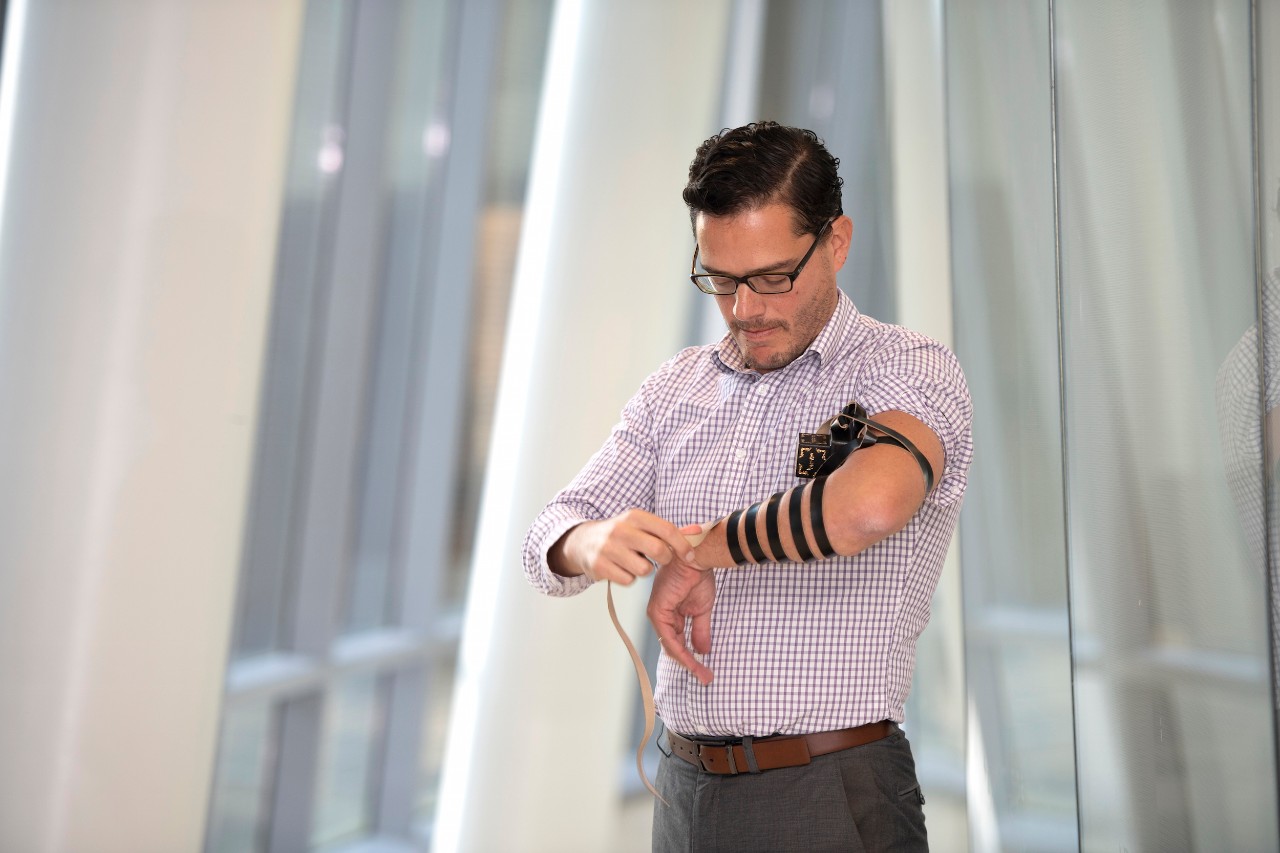
UC research shows benefits from Jewish tradition
Study shows expanded cardiovascular benefits wearing tefillin around the arm in both men and women
Research from the University of Cincinnati shows people who wear tefillin, leather bands used in a Jewish religious practice which involves the tight wrapping of an arm with the bands, may receive cardiovascular health benefits.
The study suggests those benefits are the result of ischemic or reduced blood flow preconditioning which produces protection from the damage caused by heart attacks.
The research was published in the journal PLOS ONE and expands on similar research by Rubinstein from 2018 that only enrolled men in the study. This study included both men and women.
“Tefillin is used for morning prayers for Jewish men over the age of 13 on an almost daily basis,” says Jack Rubinstein, MD, of the Division of Cardiovascular Health in the UC College of Medicine. “It is placed on the nondominant arm around the bicep and the forearm in a fairly tight manner. It is never worn in a fashion as to occlude the blood flow. This is traditionally worn for about 30 minutes continuously during prayers which involve sitting and standing resulting in occasional retightening of the strap around your arm.”

Jack Rubinstein, MD, of the Division of Cardiovascular Health at the UC College of Medicine/Photo/Colleen Kelley/UC Marketing + Brand
The use of tefillin dates back to scriptural commandments urging the faithful followers to comply with religious law and to “bind them as a sign upon your arm.” Rubinstein says the binding of the arm and the discomfort users often report may serve as a form of preconditioning and offer a substantial degree of protection against the damage that occurs when someone suffers a sudden loss of blood flow (acute ischemia) or after the blood supply is restored to a tissue or organ after an ischemic event (reperfusion). Such injuries occur during a heart attack when a section of the heart is deprived of oxygen and then damaged further when blood flow is reestablished.
Rubinstein says the researchers measured baseline information on all participants for 10 minutes in the morning, and then another round of data was obtained during and after 30 minutes of wearing the tefillin. The 30 participants, all healthy individuals between the ages of 18 to 40, had their heart rate measured before, during and after the wearing of tefillin.
“What we found is that wearing tefillin in both male and females caused changes to the heart rate associated with lowering of the metabolism as measured via heart rate variability,” says Rubinstein who explains that heart rate variability is how much variability there is between one heartbeat and the next heartbeat. “We can measure all kinds of different things from heart rate variability including probably the most important which is parasympathetic tone. Does it relax you and does it cause your metabolism [to] come down?”
This is a potential game changer for how we approach cardiovascular disease prevention
Jack Rubinstein, MD
The sympathetic and parasympathetic nervous systems have opposite roles. While the sympathetic nervous system carries signals that put the body's systems on alert, the parasympathetic carries signals that relax those systems. The two systems work together to keep the body in balance.
Rubinstein says this study shows there is a measurable effect during and after wearing tefillin.
“It means that if we can have people wearing tefillin or a similar device, and they can get themselves to be preconditioned every day, we expect that those people should be protected or should have a decreased amount of damage if they should get a heart attack during the time they are protected,” he explains. “This is a low-intensity way of protecting people from heart attacks.”
While wearing tefillin is a traditional practice of Orthodox Jewish men, Rubinstein points out this research did not include any usage of anything containing sacred religious text. He also says that the frequency of heart attacks, which according to the Centers for Disease Control and Protection strike more than 800,000 people in the United States each year, makes this research potentially very impactful.
“You have a very common and very deadly disease. We are showing a path through which anyone can precondition themselves to decrease the amount of damage that they suffer from a heart attack by wearing a very simple device,” says Rubinstein. “This is a potential game changer for how we approach cardiovascular disease prevention. Decreasing the amount of heart attack damage by even just two-fold is something that will change outcomes for millions of people.”
Lead photo of Rubenstein wearing a tefillin/Colleen Kelley/UC Marketing + Brand
Next Lives Here
The University of Cincinnati is classified as a Research 1 institution by the Carnegie Commission and is ranked in the National Science Foundation's Top-35 public research universities. UC's graduate students and faculty investigate problems and innovate solutions with real-world impact. Next Lives Here.
Related Stories
UC College of Nursing Professor honored with AANA education excellence award
December 23, 2025
Susan Newell, assistant professor in the UC College of Nursing, is being recognized by the American Association of Nurse Anesthesiology (AANA) as one of three top educational administrators and instructors. She will receive the Clinical Instructor of the Year Award during AANA's top educator event 2026 EDGE Conference, February 4-7 in Louisville, Kentucky.
Challenges for veterans in the workforce
December 22, 2025
A new research review examines how veterans and their families impact the economy.
A partnership to end pancreatic cancer
December 19, 2025
Since 2010, BSI Engineering has raised more than $1.2 million for pancreatic cancer research at the University of Cincinnati Cancer Center in honor of a friend and inspiration to BSI’s founders, Bryan Speicher.
